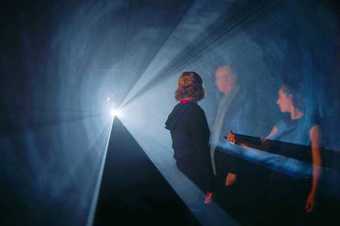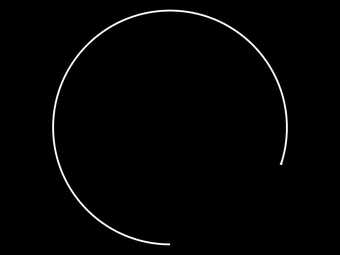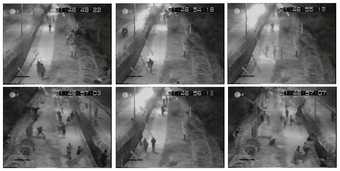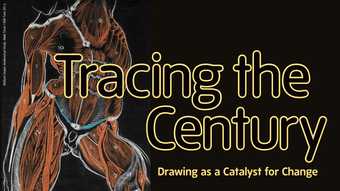
Anthony McCall
Line Describing a Cone (1973)
Tate
In the late 1960s, a number of artists who had trained as sculptors, and whose most well known work was sculpture, started working with film (Robert Morris, Richard Serra, Robert Smithson). Around the same time, independent filmmakers who did not necessarily identify themselves as ‘artists’ began to consider the sculptural dimensions of film – paying attention not just to the images that they presented on the screen, but to the texture of the film emulsion, the sound of the projector, the space between projector and wall. These practices have been the focus of recent curatorial attention – notable exhibitions being Chrissie Iles’s Into the Light and X-Screen at Mumok in Vienna, and Stuart Comer’s film programmes at Tate Modern. At the same time, art historians such as George Baker and Maxa Zoller have turned to these practices, debating terms such as ‘expanded cinema’, ‘film beyond its limits’, ‘structuralist film’, ‘sculptural film’, etc.
One of the most important works of the period was Anthony McCall’s Line Describing a Cone, a work he described as ‘the first film to exist in real, three-dimensional space’. This was made in 1973, first shown in the context of ‘independent film’, and more recently displayed in art museums. The work was especially important to sculptors such as Richard Serra, and supposedly determined Gordon Matta-Clark’s decision to make Conical Intersect. The film is visible on the screen first as a white dot on a black ground. This dot grows into a line, which arcs around to form a circle. Over the duration of the film, all that is visible on the screen is the slow drawing of this circle. Meanwhile, between the screen and the projector, the beam of light is visible as a gradually growing cone, made visible as particles in the air are illuminated by the projector. For the viewer, therefore, there is no one point of focus: they can watch the growing circle on the screen, or the growing cone between screen and projector, or move their eyes between the two. More importantly, they can move their bodies: the space is empty of any seating, and this means that the viewer can also decide to ‘break’ the cone by inserting themselves between the projector and the screen. This dimension of viewing becomes more intriguing when more than one viewer sees the work at the same time – as each person decides whether a particular kind of behaviour in the space will affect the other’s experience. McCall originally conceived the work as an assault on cinematic conventions. ‘Line Describing a Cone is what I term a solid light film. It deals with the projected light beam itself, rather than treating the light beam as a mere carrier of coded information, which is decoded when it strikes a flat surface … This film exists only in the present: the moment of projection. It refers to nothing beyond this real time. It contains no illusion. It is a primary experience, not secondary: i.e., the space is real, not referential; the time is real, not referential.’
Line Describing a Cone was initially shown as a 16 mm projection, and therefore many of the questions around the long-term fate of this medium are pertinent to it. Since 16 mm film is fast becoming obsolete, should the work be digitally transferred and projected from a digital projector? Or is it crucial to the work that the film strip is visible and audible in the space, whirling through the projector? These are questions that many of McCall’s generation have faced: some have been happy to adapt old work to new technological conditions, others not. Meanwhile as some younger artists embrace new technologies as fast as they become available, others working with 16 mm film have found ways to celebrate its qualities and mourn its passing (Tacita Dean’s Kodak, most powerfully).
But questions around future possible replication are more complicated than usual in connection to Line Describing a Cone, for two important reasons. Whilst many sculptures discussed in this workshop exist in one single original material form, the ‘materials’ of McCall’s work have changed over time. Initially, the film was projected in spaces which had sufficient dust or smoke to make the beam visible. But changing architectural and institutional conditions, and cleaned-up spaces rendered the work invisible. McCall therefore began to use a hazer. What does it mean to think about the replication of a work when the materials of the work have shifted since its original conception? Second, McCall himself has begun to make new work, since around 2002, using digital procedures, work that relates formally to Line Describing a Cone. Clearly this means that he is not an artist who is wary of new technologies. But does this shift in his work from analogue to digital procedures permit us to think differently about the identity and possible replication of the work he made before this shift? In other words, just because McCall now works with digital media, does that mean that curators and conservators should feel more permission in future to show Line Describing a Cone using new technologies than they would if they were showing the analogue work of an artist who always insisted on analogue technologies?
These questions were the basis of the interview with McCall, conducted by email in October 2007:

Fig.2
Anthony McCall
Line Describing a Cone 1973
Frame from the twenty-fourth minute
Tate © Anthony McCall Photo: Henry Graber
When you first showed Line Describing a Cone, did you project the film onto a screen or just onto the walls of a space?
Line Describing a Cone was projected onto the walls of the space, never a special screen. As long as it was a flat and uneventful surface it was fine. The wall was simply the place where the beam ended.
Did you specify the distance between projector and screen?
When I first showed it I was almost always present. It was more a question of improvising with what was available rather than specifying special requirements. There was a projector, and perhaps it had a zoom lens and perhaps a fixed lens. The space was usually a given. The showings (always called ‘screenings’ then) took place at either downtown, avant-garde film places like Millennium Film Workshop, the Collective for Living Cinema (New York), or London Filmmakers Co-operative (London), or at small, alternative or general arts spaces like Artists Space in New York. Preparation for a showing consisted of removing and stacking any chairs, setting up the projector on a stand, testing it to see what sized image one could get, and improving the black-out. At the time, if I were asked, I’d probably just say that the room should be decent length, ‘decent’ meaning over twenty-five feet with thirty to forty-five feet being optimum.
You’ve mentioned to me before that you showed in dusty spaces where the cone was visible just because of these particles. When was the first time that you showed it in cleaner spaces and encountered the fact that the cone was not always visible?
Visibility is also an issue. These pieces are visible in three-dimensional space because the projected light is reflected off tiny particles in the air. In the days when they were made, loft spaces were grittier and dustier than they are now, being then much closer to their earlier lives as sites for manufacturing or warehousing; the same was true of the downtown exhibition spaces. When I projected a film then, I could rely on the dust particles in the air, which would often be augmented by a couple of smokers. Since then exhibition spaces have become cleaner, and smoking has been prohibited. Fortunately, technology has caught up, and we now thicken the air with a small fog machine, which actually does a far more effective job of making visible the planes of light.1
The first time that I realised I had a visibility problem was when I participated in a large exhibition at the Malmö Konsthall in 1977, New Media I (just to note, in 1977 New Media meant artists using photography). Line Describing a Cone was to be shown on one evening, to an assembled audience. A large room had been set up with the projector on a stand at one end, and gradually people arrive until there was an audience of about fifty people. The lights were extinguished and the film began.
At the time I was used to the first few minutes being difficult for the audience, since there was little ‘to recognise’ that resembled a film. But always, after five minutes or so, enough individuals would grasp what was going on that the piece then took off on its own, and within ten or twelve minutes, the audience had been drawn in and would become increasingly involved as the cone grew.
On this occasion, however, things were different. Three minutes came and went; then three more, then three more still. To my amazement, the beam of light that had always reliably presented itself in the space between the projector and the wall, failed to materialise. It simply was not there. Realising the problem, I raced out of the Konsthall, and across the road to a tobacconist, and hurried back into the projection space with three, lit, Swedish cigarettes in my mouth. I blew smoke into the air near the beams in an attempt to make them visible. This did help. However at that moment I was tapped on the shoulder. I turned round to find an angry-looking guard who confiscated the cigarettes and ordered me out of the room. So for the next fifteen minutes, an art audience drawn from the city of Malmö politely watched a three-dimensional projection that was absolutely invisible. If they were bored or disappointed, they didn’t show it. This experience brought home to me forcefully something that had been growing as a realisation over the past two or three years: that the visibility I had assumed for my films was in fact not universal, but came out of the fact that my films had been shown mostly in downtown lofts or factories, which were full of dust. This dust was the source of the projected beam’s visibility. Once out of that environment and into the cleaner air of museums and galleries, the beams vanished.
When was the first time you used a hazer to show the film?
The hazer was not commercially available, as far as I know, until about 2001 or 2002. But I used an earlier version of it, the fog machine, in 1990, when a group of my films were shown as part of a series of artists films at Anthology Film Archives in New York (the programme also included James Lee Byars, Joseph Beuys, John Baldessari). My work was shown in the basement gallery, empty of chairs. The small fog machine we used produced an intermittent jet of white fog accompanied by a rather fierce hissing sound. It was obtrusive, and over-dramatic in the way that the fog ‘boiled’ into the projected beam, but it did enable the projected forms to be seen. I continued to use such a device after that on the few occasions that one of my films was shown, and I began to add a small fan, which dispersed the jet of fog more evenly into the space. I used the small fog machine plus a timer, plus a fan, in the first installation presentation of Line Describing a Cone in the Chrissie Iles exhibition Into the Light at the Whitney in 2000, and in the Expanded Cinema section of Shoot Shoot Shoot at Tate Modern in 2002.
It must have been around that time (and by 2002 I was already developing specific ideas for new films) that I discovered that the ‘Haze’ machine had been invented. This was related to the fog machine, but it was based on a water-plus-glycol (a derivative of starch) solution, rather than oil, and it produced not a smoke-like fog, but instead something quite a bit thinner, like an ambient sea-mist. This was ideal in that its presence rendered any beam of light projected through it intensely visible, even though it was in itself, quite unobtrusive. Within a couple more years Jem Martin came out with a model which included a twenty-speed built-in fan, twenty calibrations of haze volume, and a built-in timer. Unique in Germany brought out a related machine. These turned out to be the ideal black box for both continuous installation and once-through showings. The haze machine also had the advantage of being non-toxic and odourless, and unlike the oil-based machines, it left no residue on surfaces in the space.
Since then I have fine-tuned how I like to set them up. The first principle is that too much haze is as bad as too little. When you look up in the installation into the dark, it should not be immediately obvious that the room has haze in it at all. Secondly, I like to set the machine to run intermittently on/off quite often. For instance, on one recent installation the machine was set to go: ‘Off for 60 seconds, On for 30 seconds, in repeating cycles’. This meant that the visitor would repeatedly see the arrival of the haze into the form which helped to repeatedly ‘describe’ its shape; the ‘time-off’ period also prevented an unwanted build-up of ambient haze. The fan was set as low as possible given the dimensions of the space, to avoid the over-dramatic properties of fast entry into the light.
One final comment. The film projection apparatus, the institutionally peripheral venues (out-of-the-way, dusty spaces), plus the discourse of de-construction within which the works were made and thought about, seem now to be very far away. The hazer is certainly a marker of the changes that have occurred. I suspect that my films seemed to be far more ‘conceptual’ then – glimpsed rather than seen outright, perhaps. But for me the hazer has allowed the realisation of how I had always imagined the works in my mind’s eye. It is a fact that Long Film for Four Projectors 1974, was only seen as it needed to be seen when it was shown at Tate, in 2004, thirty years after it was made, with two haze-machines generating an even mist throughout the Linbury Gallery space. Back in 1974 and 1975, although I experimented with a set of sand-filled film cans seeded with smouldering charcoal cakes and frankincense, I never really solved the problem of how to make visible an installation planned for a 22 x 11 metre space with beams intersecting every part of it. And by removing the problem of visibility, and of scale limitation, the hazer has enabled me to move in directions that would have been impossible in the 1970s.
When was the first time you had to provide a list of materials involved in the work – such as ‘screen, projector, hazer’? Was this when you first sold the work to a museum?
No, it was no more sales than anything else. In the 1970s, one always noted medium but since I showed then mostly within a film context, not much stress was placed on the medium. It was simply a question of saying ‘16 mm, black-and-white, silent’ or something like that. Most film showplaces had the equipment waiting, even if the format of my works was unorthodox.
These days, technically, an installation can be almost anything, and all of its components have to be described. Whether I am going to do an installation somewhere, or whether an institution is considering purchasing a piece, there is a need for them to know in advance precisely what may be involved. When Pompidou and La Maison Rouge did the mini-retrospective in 2004, for instance, it was vital to draw up a list of equipment since some of it was not easy to find anymore: the four 16mm projectors with the extra-bright xenon lamps, which were necessary for Long Film, were eventually only assembled by borrowing the projectors, individually, from different cities in France. The Kodak Carousel projector had to be hunted down also. Then there are two technologies around for video projectors (LCD and DLP), and it was essential that I specified which one (it had to be DLP because of its superior black), and also essential to specify the brightness of the lamp (since there are many possible intensities).
Collecting institutions now also have to take on the problem of obsolescence. This is a relatively new problem and a complicated one – not only because the technical issues are continuous and complicated (which they can be), but because software upgrades and hardware changes may significantly alter the aesthetic values of the works in question.
But this is a moving target for all of us, including artists making work now. I have already re-made Doubling Back 2003, and Turning Under 2004, to improve on the original screen resolution and to improve on the smoother motion made possible by the new Flash Action Scripting. I have also found that I like it when brighter projectors come out. Two years ago, 2,000 lumens seemed pretty good, but now 4,000 lumens is my standard. This being in the middle of continuous change makes it very hard to write definitive recipes for the future.
Since you made the work in the early 1970s, you began to use digital media to make and project your solid light films. Is it still important to you that Line Describing a Cone be shown on 16 mm though? If so, why?
It is important. This became very clear in my exhibition at the Musée de Rochechouart, where the installation of Line Describing a Cone was directly next to the installations of three digital works from the last few years. It was striking how ‘hand-made’ the lines of the 1973 work seemed by comparison to the mathematically generated lines of the digital works. Line Describing a Cone was my first animated film, and it was made on an animation stand by rotating a line drawing of a white semi-circle from under a mask. Very basic, and hit-and-miss enough that at one point in the finished work, there is a noticeable split between the semicircular lines. The semi-circle was drawn with a ruling-pen compass and gouache, and the line thickness varies enough that the difference is visible in the film.
When a 16 mm film is projected, there is a noticeable tremor to the projected image whereas the digital works, by comparison, are rock steady. Then there is the fact that the digital planes of light carry longitudinal striations which radiate from lens to wall (these are simply elongated pixels). The surface of the planes of light thrown by the film projector, by comparison, are like unblemished silk. With digital images on the wall, black is black. But the black emulsion of a the high-contrast film stock (of the original negative as well as of the projection prints) has, over the years, become picked at by wear and tear, producing (especially at the head and the tail of the prints) tiny white flecks which now project as a little blizzard of shooting stars.
You could say that film, being analogue, exhibits its age. And you could say that this difference is part of the material character of the medium. This may account for my affection for some of these effects. Those shooting-stars were not part of the original conception, but they now seem part of the work. I actively like them. The work has acquired patina. Digital works do not do that, unless of course, it is ‘scripted’ in.
If someone were to want to screen the film in fifty years time, and all the prints had deteriorated, and no other 16 mm prints could be produced, would it be true to the work to make a digital animation of Line Describing a Cone and project it from a digital projector?
If all the prints had deteriorated and no other prints could be produced, then a new digital animation would be the only way to even approximate the experience. So it would be better than nothing, of course. But whether it was ‘true’ or not is a bit more complicated.
What would be made? There would be two choices perhaps:
1) A digital copy of the original film, retouched to remove all the scratches and flecks and detritus that had accumulated on the worn-out prints, but retaining all its hand-made properties like the place where the semi-circles do not quite meet, or the variation in the line thickness? It would certainly be possible to even simulate the slight tremor produced by a 16 mm film projector, and I’ll bet that there would be a discussion as to whether the sound of the film projector should be laid down as the ‘authentic’ sound of the work.
2) A digital re-make of the film, using digital scripting. This would certainly be possible. It would be a new version entirely, completely true to the original conception (a white circular line gradually forming a circle), but with none of the irregularities of the film that was actually made (after all, from the start I acknowledged the irregularities as such – as departures from the purity of the idea – but I accepted them). So the re-make might be justified as a distortion but one that was true to the original conception, and the experience of watching it could be compared to the footage that existed of the film being projected with its audience. And this digital version might be justified on the grounds that the artist himself had already gone this route – for instance, his oft-reproduced stills from the film were not stills at all, but new circular line-drawings (and later on, digitally manufactured line drawings) which were done that way because it was a lot easier than isolating a part of the film and making a copy of it.
But are these the choices, in fact? We have no idea what exhibition technologies may exist in fifty years: for instance, how can we be sure that ‘projection’ will still be with us? There may be easier ways to make big images.
We are also assuming that film technologies will slide into oblivion. Of course they may. But it is also possible that there will continue to be enough business for at least one company to keep making film (primarily for the conservation of digital movies perhaps?). It would also be quite easy to make batches of hybrid 16 mm projectors by hand – the mechanics would be made in a machine shop, but there is no reason why the lamp and the optics shouldn’t be off-the-shelf, for lamps and optics have not changed that much. A combination of those two things plus decent archiving in between by collecting institutions would mean that it could still be possible to make prints and project them on a machine not unlike its original.
Thirdly, there is the artist to consider. I have already decided that if anyone is going to make a digital version of Line Describing a Cone, it should be me. What I plan to do (it is not in my schedule yet, though) is to re-make the piece with digital scripting. It will be perfect, exactly as conceived. There will be no imperfections. It will be silent. It will be titled Line Describing a Cone 2.0, thus marking it not as a re-make at all, but as a second version. It would not replace the film version. It may be that over time, 2.0 gets looked at more than the film version. Or it may be that 2.0 drives people back to the film version. I have no idea. But I do like the idea of taking the law into my own hands.



